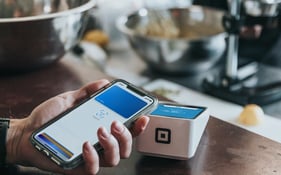To little surprise, the pandemic sent to-go orders soaring. According to the National Restaurant Association’s 2022 State of the Industry report, six in 10 adults say they’re more likely to order either takeout or delivery than they were before the pandemic. And those numbers appear to match up with actual orders being placed. In a survey by Deloitte taken last September, more than 60-percent of respondents said they order delivery or takeout once a week, up from 29-percent a year ago and 18-percent before the pandemic.
For many restaurants, carryout has shifted from a nice add-on to an essential lifeline to stay alive. And its popularity among consumers isn’t expected to fall anytime soon. But for restaurants, the competition is now higher than ever, and as we all know, executing carryout isn’t always easy.
So how can you elevate your restaurant’s experience in order to stand out? To help weigh in on that question, we spoke with Washington City Paper’s new “carryout critic” Crystal Fernanders, who regularly reviews restaurants across D.C.
As a culinary grad with a decade of experience as a chef, Fernanders brings perspective from both sides of the plate. She’s also the current general manager at D.C.’s Captain Cookie and the Milkman, and in her free time, she runs a food blog, TikTok, and Instagram, where she’s been doing her own reviews for years.
“Because I understand both the customer aspect and the cooking side, I have some sympathy,” says Fernanders. “If there’s a small mishap, I’m not going to make a big deal out of it because I know it might just be that you’re dealing with a short staff or supply issues.”
Although Fernanders is forgiving, she notes that there are plenty of small improvements restaurants can take to significantly benefit the customer experience. We asked her to share her top takeout advice with us.
Get a QR code menu to increase convenience
Fernanders knows that not everyone is a fan of the QR code menu. But she considers it a must-have when it comes to takeout. It’s one added step that can make ordering quicker and easier for customers. And it allows guests who prefer a more contactless experience to opt for it.
“Every restaurant should offer a QR menu even if they don’t make customers use it,” says Fernanders. “It’s not just more convenient for the customer, but it also benefits the restaurant, especially with businesses being short-staffed. That’s one less customer you’re dealing with in the store, and it’s just all around less work.”
Make your QR codes visible so that customers can access the menu as soon as they step in line. Of course, staff should still be present to field any questions. And Fernanders suggests having some hard copy menus available, too. Yet, QR code menus will free up your staff from having to enter every single order.
Choose the right packaging
Packaging can make a huge difference for how your food is received once finally delivered to the customer. For Fernanders, she’s interested in options that bring convenience.
“A lot more restaurants are doing disposable containers, or even Tupperware containers, that are microwave-safe, so you don’t have to take your food out and put it on a plate to reheat,” says Fernanders. “There’s usually a symbol on the bottom that shows it’s microwavable.”
Microwavable containers come in all shapes and sizes. You can check out a few options here. If going this route, make sure your customers know the containers are microwavable by communicating this with each order. Eliminating the guesswork creates a more seamless experience.
Provide reheating instructions
Your kitchen staff puts time and care into every dish. And you want your customers to experience the food at its prime. This means it needs to be eaten at the temperature you intended.
Unless picking up takeout to enjoy on the spot, this will often require food to be reheated. “With some pizza spots, right on the box it’ll say, ‘here’s how to reheat me’, and I love that because you know exactly what to do,” says Fernanders.
Make this process a no-brainer by including a handout that details specific reheating instructions with each to-go order. If able, Fernanders suggests also including instructions on your website or within menu descriptions detailed on third-party apps for customers to reference.
Be extra mindful with noodles
Take it from ramen shops who know this rule well: Package noodles separately when liquid’s involved. This prevents the noodles from overcooking and absorbing a majority of the liquid by sitting in the broth for too long. And it’s not just soup. You’ll want to treat other types of noodle dishes with extra awareness, too, says Fernanders.
“A lot of chefs want the sauce tossed with the pasta, which is fine, but have a container of extra sauce on the side,” she says. “The noodles will soak up all that sauce before you get home, and I still want to be able to taste the sauce on its own.”
Details matter if you want to stand out, notes Fernanders.
Include a space for requests on online orders
Sure, customer modifications can feel equal parts annoying and time-consuming. But if your kitchen can handle it, including a modification box for online and delivery orders can draw in customers, says Fernanders. This prevents the customer from having to spend time calling the restaurant to see if dishes can be adapted for allergies or other dietary restrictions.
“It’s helpful for things like asking for sauce on the side, omitting an ingredient that doesn't change the dish completely, or specifying allergies,” says Fernanders.
Customer service still matters with takeout
Of the many carryout experiences Fernanders has had over the years, there’s one that sticks out the most – a meal at MLK Deli in D.C.’s Congress Heights. And it’s not just because the food was delicious.
“When I showed up for the very first time, there was this feeling like I’d been there before because everyone was so friendly and welcoming,” says Fernanders. “With takeout, the food is probably the most important part, but it’s also the experience, and when you’re not dining in, the customer service is what makes up for that dining experience.”
Someone could like your food, but if they have a bad customer service experience, it’s possible they won’t return. Meanwhile, if a customer has a personable and pleasant experience, they’re likely to be more forgiving if something small goes wrong, like a missed side of ranch in the bag. And it could be that extra step to win out against your competitors. “You can look at Chick-fil-A, for example. It’s just chicken sandwiches, but ask people what they like about Chick-fil-A, and the common denominator is always their customer service,” says Fernanders. “Customer service is what gets people coming back.”
Photograph your dishes to draw in customers
Takeout doesn’t bring the same, immersive experience as dining in, which makes photos of your food an extra valuable asset, says Fernanders. This is especially true given the abundance of takeout competition that now exists.
“I usually rely on social media. You’ve got to know what you’re eating – the eyes eat first,” she says. “Even though it’s 2022, we don’t have scratch and sniff on our phones, and we want to know if it’s worth the money.”
When able, include photos on your website, and utilize platforms like Instagram and Facebook to show off the dishes that travel best.
Double check orders before they’re sent out the door
Orders go out all the time with missing or incorrect items. While it’s a common mistake, it’s also an easy fix.
“Mistakes happen, but you can try to avoid it by double-checking each order,” she says.
If your staffing situation allows, designate this duty to one person per shift.





